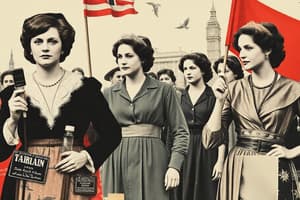Podcast
Questions and Answers
In what year was a law passed that prosecuted anyone who tried to prevent the vote of any citizen?
In what year was a law passed that prosecuted anyone who tried to prevent the vote of any citizen?
- 1965
- 1960
- 1957 (correct)
- 1955
What was the primary goal of the peaceful sit-ins and demonstrations during the civil rights movement?
What was the primary goal of the peaceful sit-ins and demonstrations during the civil rights movement?
- To end segregation in public facilities
- To elect more African-American politicians
- To promote violent protests
- To test the advancements they had gained in the south (correct)
Who delivered the famous 'I have a dream' speech during the March on Washington in 1963?
Who delivered the famous 'I have a dream' speech during the March on Washington in 1963?
- Barack Obama
- John F. Kennedy
- Martin Luther King, Jr. (correct)
- Malcolm X
What was a key provision of the Civil Rights Act of 1964?
What was a key provision of the Civil Rights Act of 1964?
What event led to the blocking of peaceful civil rights demonstrators by the state in 1965?
What event led to the blocking of peaceful civil rights demonstrators by the state in 1965?
Who was the black US president elected in 2008?
Who was the black US president elected in 2008?
What was the focus of the civil rights movement from the 1980s onwards?
What was the focus of the civil rights movement from the 1980s onwards?
What act was passed in 1968 to prevent discrimination in housing?
What act was passed in 1968 to prevent discrimination in housing?
Who was assassinated in 1965, a leader of the civil rights movement?
Who was assassinated in 1965, a leader of the civil rights movement?
What is still a relevant and endemic social problem in the US, according to the passage?
What is still a relevant and endemic social problem in the US, according to the passage?
Flashcards are hidden until you start studying
Study Notes
Women's Suffrage in the American Context
- The demand for women's suffrage in the American context began to gain strength in the 1840s, emerging from the broader women's rights movement.
- The Seneca Falls Convention (1848) was the first women's rights convention, where a resolution in favor of women's suffrage was passed.
- The first national suffrage organizations were established in the 1870s, including the National American Woman Suffrage Association (NAWSA) and The Women's Christian Temperance Union (WCTU), later joined by the National Woman's Party (NWP).
- These organizations demanded voting rights, but their appeals were rejected, leading them to advocate for state-by-state amendments to the U.S. Constitution.
- Women gained suffrage in Washington state in 1910, but not all states allowed women to vote under the same conditions and for the same type of elections.
- The Progressive Party, formed by Theodore Roosevelt, endorsed women's suffrage in 1912.
- The outbreak of World War I in 1917 had a significant influence on the suffrage movement, as women replaced men in home front jobs.
- Women pioneers in this period showed that women could be pilots, political activists, professors, and even fly across the Atlantic and Pacific like Amelia Earhart.
- By the end of 1919, women could effectively vote for president in most U.S. states.
- The Nineteenth Amendment to the United States Constitution was passed in 1920, allowing women to vote in every state.
Women's Rights and Fairy Tales
- Women's rights and fairy tales have a complex history, with fairy tales often being used to teach moral lessons and reinforce social norms.
- The Grimm Brothers compiled fairy tales, introducing a fixed structure and two types of tales: miracle tales and cautionary tales.
- Fairy tales were not initially intended for children, but for a wider audience.
- The introduction of the printing press in the 15th century favored the creation and circulation of books, leading to a rise in reading.
- The first book aimed at children learning to read was Orbis sensualium pictus (1658) by Johann Amos Comenius.
Early Writing for Children
- During Victorian times, children's literature conveyed moral and social values, aiming to instruct children through narratives.
- Fantasy and fairy tale literature proved highly popular, with authors like the Brothers Grimm, Hans Christian Andersen, and Lewis Carroll.
- The characteristic features of Romanticism, such as imagination, individuality, and originality, also appeared in children's literature.
- The concept of childhood was idealized, and children were seen as innocent vessels of curiosity and potential.
Civil Rights Movement
- In 1957, a law was passed to prosecute anyone trying to prevent citizens from voting.
- The civil rights movement promoted peaceful sit-ins and demonstrations, testing advancements in the south.
- The rides continued in the U.S. under the Kennedy administration in 1961, with the ban on segregation in interstate transit.
- In 1963, a march on Washington was organized, with Martin Luther King Jr. delivering the "I Have a Dream" speech.
- The Civil Rights Act of 1964 guaranteed equal employment, voting rights, and integration of public facilities.
- However, conflict continued, with the assassinations of Malcolm X in 1965 and Martin Luther King Jr. in 1968.
- Additional civil rights laws were passed, including the Fair Housing Act of 1968.
Studying That Suits You
Use AI to generate personalized quizzes and flashcards to suit your learning preferences.




